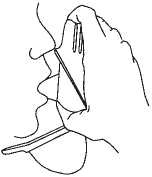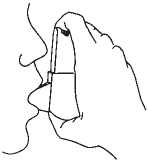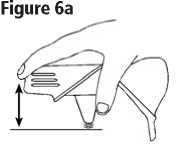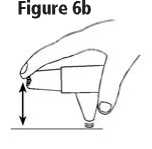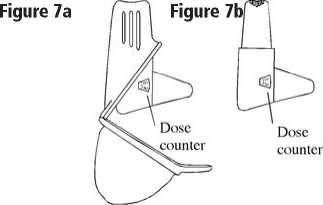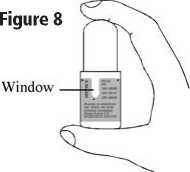Easyhaler Salbutamol Sulphate 200 Mcg/Actuation Powder
Out of date information, search anotherPackage leaflet: Information for the user
Salbutamol sulphate (salbutamol)
Read all of this leaflet carefully before you start using this medicine because it contains important information for you.
• Keep this leaflet. You may need to read it again.
• If you have any further questions, ask your doctor, pharmacist or asthma nurse.
• This medicine has been prescribed for you only. Do not pass it on to others. It may harm them, even if their signs of illness are the same as yours.
• If you get any side effects, talk to your doctor or pharmacist. This includes any possible side effects not listed in this leaflet. See section 4.
What is in this leaflet
1. What Easyhaler Salbutamol is and what it is used for
2. What you need to know before you use Easyhaler Salbutamol
3. How to use Easyhaler Salbutamol
4. Possible side effects
5. How to store Easyhaler Salbutamol
6. Contents of the pack and other information
What is Easyhaler Salbutamol?
Easyhaler Salbutamol is a "reliever" inhaler. The active ingredient is salbutamol, an asthma medicine, which opens up the airways. Salbutamol has a quick effect and a short duration of action (4 to 6 hours).
What is Easyhaler Salbutamol used for?
Salbutamol is used to relieve symptoms of asthma and other asthma-like conditions such as chest tightness, wheezing and coughing in adults and children aged 4 years and over. It is also used for prevention of asthma symptoms brought on by exercise or a known allergen exposure that cannot be avoided.
Do not use Easyhaler Salbutamol:
• if you are allergic to Salbutamol or any of the other ingredients of this medicine (listed in section 6)
Warnings and precautions
Talk to your doctor, nurse or pharmacist before using Easyhaler Salbutamol if you have any of the following:
• any diseases affecting the heart or blood vessels
• any infection in your lungs
• overactivity of the thyroid gland
• low levels of potassium in your blood
• hereditary problems of galactose intolerance, the Lapp lactase deficiency or glucose-galactose malabsorption, you should not take this medicine.
Other medicines and Easyhaler Salbutamol
Tell your doctor or pharmacist if you are taking, have recently taken or might take any other medicines.
In particular it is important to tell your doctor if you are currently taking any of the following medicines:
• medicines for your breathing problems for example theophylline or aminophylline (xanthines)
• corticosteroids
• beta-blockers for your blood pressure e.g. propranolol
• medicines for depression
• water tablets (diuretics) and other medicines for heart problems
If you already use "preventor" medication e.g. inhaled corticosteroid, it is important to continue using it regularly, even if you feel better.
Pregnancy and breast-feeding
Easyhaler Salbutamol should not be used if you are pregnant or breastfeeding, think you may be pregnant or are planning to have a baby, unless you are advised to do so by your doctor. Ask your doctor or pharmacist for advice before taking this medicine.
Driving and using machines
Easyhaler Salbutamol will normally not affect your ability to drive or operate machinery (no formal studies have been carried out).
However, if you experience side effects such as dizziness, increased or uneven heart rate, muscle cramps or muscle pain or if you feel a bit shaky, your ability to drive or operate machinery may be affected.
Easyhaler Salbutamol contains lactose
Lactose may cause an allergic reaction. If you have been told by your doctor that you have an intolerance to certain kinds of sugar, talk to your doctor before using this medicine.
Like all medicines, this medicine can cause side effects, although not everybody gets them.
If you experience any of the following side effects, stop taking Easyhaler Salbutamol and seek immediate medical attention:
• itching, rash or reddened skin
• swelling of the eye lids, lips, face or throat
• low blood pressure or collapse
• increase in wheezing and shortness of breath immediately after dosing. Other side effects
Common side effects (may affect up to 1 in 10 people)
• feeling a bit shaky
• increased or uneven heart rate
• increased blood flow to your extremities
Uncommon side effects (may affect up to 1 in 100 people)
• headache.
Rare side effects (may affect up to 1 in 1,000 people)
• cough, mouth and throat irritation (these may be prevented by rinsing the mouth with water and spitting it out after inhalation)
• decrease in the level of potassium in your blood
• muscle cramps
• restlessness, dizziness, behavioural difficulties.
Very rare side effects (may affect up to 1 in 10,000 people)
• angina (chest pain), heart attack (myocardial ischemia).
Reporting of side effects
If you get any side effects, talk to your doctor or pharmacist. This includes any possible side effects not listed in this leaflet. You can also report side effect directly via the Yellow Card Scheme at: www.mhra.gov.uk/yellowcard. By reporting side effects you can help provide more information on the safety of this medicine.
• Keep this medicine out of the sight and reach of children.
• Do not store above 25°C.
• Before the first use store in the unopened laminate pouch. After opening the laminate pouch keep protected from moisture. It is recommended to keep the Easyhaler in its protective cover.
• If your Easyhaler Salbutamol gets damp, you will need to replace it with a new one.
• Replace your Easyhaler Salbutamol with a new one no later than 6 months after you open the laminate pouch. Write down the date you opened the pouch to help you remember.
Do not use this medicine after the expiry date which is stated on the label and carton. The expiry date refers to the last day of that month.
Do not throw away any medicines via wastewater or household waste. Ask your pharmacist how to throw away medicines you no longer use. These measures will help protect the environment.
See "Instructions for using your Easyhaler" at the end of this leaflet.
You will be shown how to use the Easyhaler by your doctor or asthma nurse. Always use this medicine exactly as your doctor or asthma nurse has told you. Check with your doctor or asthma nurse if you are not sure how to use the Easyhaler, how many puffs (actuations) to take or how often to take it.
IMPORTANT-contact your doctor immediately if:
• you need to use this "reliever" inhaler more often than usual
• you need to use your "reliever" more than twice a week
• your wheeziness or chest tightness is worse than usual.
The recommended dose for Easyhaler Salbutamol 100 mcg is:
Adults, Older people and Adolescents aged 12 years and over:
For the relief of symptoms of acute asthma attack and intermittent asthma the starting dose is one puff (100mcg) that may be increased to two puffs (200mcg). To prevent symptoms before exercise or contact with whatever triggers your asthma attack the starting dose is two puffs (200mcg) that may be increased to four puffs (400mcg).
Children aged 4 to 11 years:
For the relief of symptoms of acute asthma attack and intermittent asthma the dose is one puff (100mcg) as required. This may be increased to two puffs (200mcg) if required.
To prevent symptoms before exercise or contact with whatever triggers your asthma attack the dose is one puff (100mcg). This may be increased to two puffs (200mcg) if required.
For regular treatment the dose is up to two puffs (200mcg) up to 4 times a day.
Children should always have adult supervision when using the Easyhaler
The maximum daily dose (in 24 hours) for both adults and children aged 4 years and over: 8 puffs of the 100 mcg (800 micrograms).
The recommended dose for Easyhaler Salbutamol 200 mcg is:
Adults, Older people and Adolescents aged 12 years and over:
For the relief of symptoms of acute asthma attack and intermittent asthma the starting dose is one puff (200mcg) that may be increased to two puffs (400mcg). To prevent symptoms before exercise or contact with whatever triggers your asthma attack the starting dose is one puff (200mcg) that may be increased to two puffs (400mcg).
Children aged 4 to 11 years:
For the relief of symptoms of acute asthma attack and intermittent asthma the dose is one puff (200mcg) as required.
To prevent symptoms before exercise or contact with whatever triggers your asthma attack the dose is one puff (200mcg).
For regular treatment the dose is one puff (200mcg) up to 4 times a day. Children should always have adult supervision when using the Easyhaler
The maximum daily dose (in 24 hours) for both adults and children: 4 puffs of the 200 mcg (800 micrograms).
If you use more Easyhaler Salbutamol than you should
If you have taken more puffs than recommended, you should contact your doctor immediately. You may notice that your heart is beating faster than usual and that you feel shaky. These effects usually wear off in a few hours.
If you forget to use Easyhaler Salbutamol
If you forget to take a dose do not worry. Take your next dose when it is due or if you become wheezy. Do not take a double dose to make up for a forgotten dose.
If you have any further questions on the use of this medicine, ask your doctor, pharmacist or nurse.
What Easyhaler Salbutamol contains
• The active substance is salbutamol sulphate
• The other ingredient is lactose.
What Easyhaler Salbutamol looks like and contents of the pack White or almost white inhalation powder.
Easyhaler multidose powder inhaler contains 200 doses (puffs). Packages:
200 doses in plastic multidose powder inhaler
200 doses in plastic multidose powder inhaler and protective cover
A protective cover is also available separately.
Marketing Authorisation Holder
Orion Corporation Orionintie 1 FIN-02200 Espoo Finland
Manufacturer
Orion Corporation, Orion Pharma Orionintie 1 02200 Espoo Finland
This leaflet was last revised in March 2015
120205-13
INSTRUCTIONS FOR USING YOUR EASYHALER
Easyhaler Salbutamol is easy to use. Read through these instructions first. They tell you what you should do and what to look out for.
UNPACKING THE INHALER (Figures 1 and 2)
The inhaler (Figure 1) comes in a laminate pouch to keep the powder dry. Do not open the pouch until you are ready to start using your Easyhaler. A protective cover is optional. If you do not use the protective cover, move on to section "Taking a dose from Easyhaler Salbutamol". Open the protective cover and insert the inhaler into it (Figure 2). Make sure the dust cap covers the mouthpiece of the Easyhaler (this stops the inhaler releasing medicine by accident). If you are not using the inhaler immediately, close the protective cover.
Taking a dose from Easyhaler Salbutamol
If you use the protective cover with your Easyhaler Salbutamol, open it. Remove the dust cap.
A. Shake (Figure 3a or 3b)
Shake the inhaler vigorously up and down 3-5 times, to allow proper powder flow and a correct dose. After shaking, hold the Easyhaler in the upright position.
B. Click (Figure 4a or 4b)
Press the inhaler once between your finger and thumb until you hear a click, and let it click back again to deliver powder into the inhalation channel inside the mouthpiece. Keep holding the inhaler in the upright position. If you think that you have clicked the Easyhaler more than once, see NOTE Figure 6a or 6b below
C. Inhale (Figure 5a or 5b)
In the sitting or standing position
• breathe out normally (but NOT into the inhaler)
• place the mouthpiece in your mouth between your teeth and seal your lips tightly around it
• take a strong and deep breath through the inhaler (Figure 5a or 5b)
• remove the inhaler from your mouth
• hold your breath for at least 5 seconds, then breathe normally.
Make sure that you do not breathe out into the inhaler, because it could clog up the inhaler. If this happens, see NOTE Figure 6a or 6b below. If you have been prescribed more than one dose, pause for one minute and repeat points A, B and C. Put the dust cap back on the mouthpiece.
NOTE! (Figures 6a or 6b)
If you click the inhaler by accident, or if you have clicked it more than once, or if you breathe out into it, tap the mouthpiece to empty the powder onto a table top or the palm of your hand (Figure 6a or 6b). This ensures proper dosing. Then start again with steps A, B and C.
CLEANING
Clean the mouthpiece at least once a week with a clean dry cloth or tissue. Do not use water or other liquids, the powder is sensitive to moisture.
If you use the protective cover, you can take the inhaler out of it to wipe it. When you are putting it back into its protective cover, put the dust cap on the mouthpiece to stop it releasing the medicine accidentally.
GETTING A NEW EASYHALER SALBUTAMOL (Figures 7a, 7b and 8)
Replace Easyhaler Salbutamol with a new one 6 months after you opened the laminate pouch. Write down the date you opened the pouch to help you remember.
The inhaler has a dose counter which shows how many doses are left (Figure 7a or 7b). The counter turns after every fifth dose (actuation). When the numbers turn red, there are 20 doses left. If you do not already have a new inhaler, contact your doctor for a new prescription. When the counter reaches 0, you need to replace the inhaler even though you can still observe the powder in the clear window on the back of the inhaler (Figure 8).
Keep the protective cover for the next inhaler.
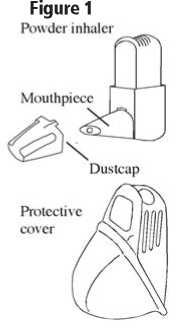
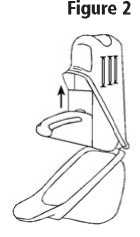
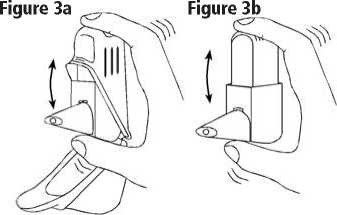
Figure 4a i Figure 4bi
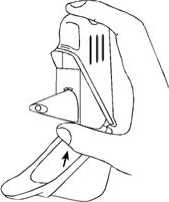
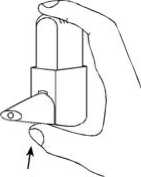
Figure 5b
